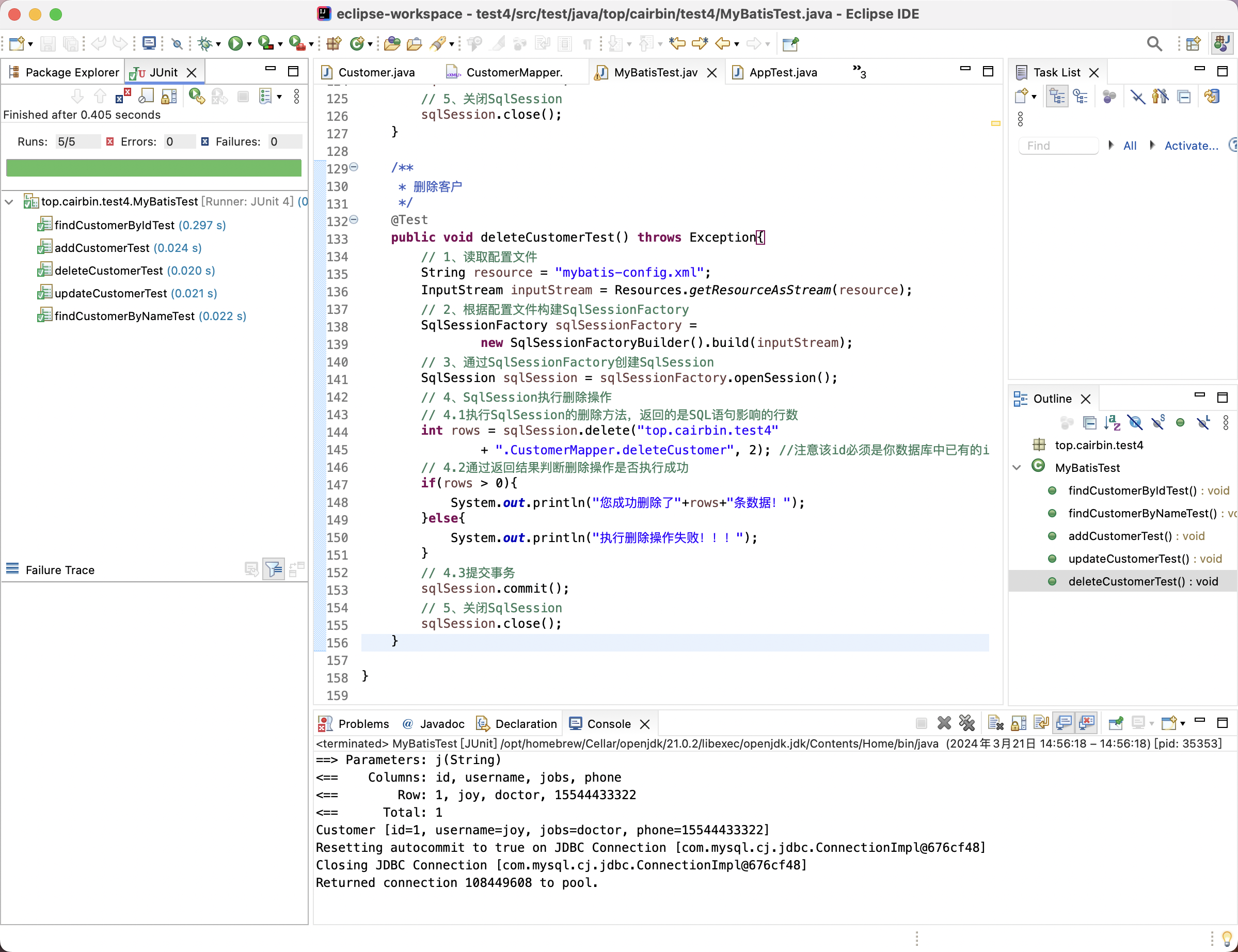了解MyBatis
什么是MyBatis
MyBatis 是一款优秀的持久层框架,它支持自定义 SQL、存储过程以及高级映射。MyBatis 免除了几乎所有的 JDBC 代码以及设置参数和获取结果集的工作。MyBatis 可以通过简单的 XML 或注解来配置和映射原始类型、接口和 Java POJO(Plain Old Java Objects,普通老式 Java 对象)为数据库中的记录。
MyBatis中文文档 可参考 https://mybatis.net.cn/。
MyBatis是不是ORM?
什么是ORM?即Object-Relationl Mapping,它的作用是在关系型数据库和对象之间作一个映射,这样,我们在具体的操作数据库的时候,就不需要再去写复杂的SQL语句。
JPA是orm框架标准,MyBatis没有实现JPA,和orm框架的设计思路完全不一样。MyBatis是拥抱sql,而orm则更靠近面向对象。Mybatis是sql mapping框架而不是orm框架,当然orm和Mybatis都是持久层框架。
MyBatis工作原理
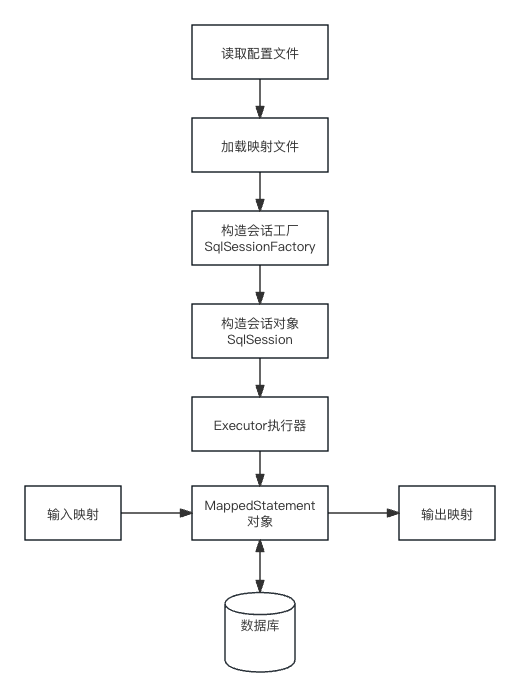
使用MyBatis
废话不多说,我们直接上手用下。
创建数据库与表
我们来创建一个名称为db_mybatis的数据库
还是老样子,我这里以终端为例,你可以用sqlyog等工具。
mysql -uroot有密码的话
mysql -u root -p执行SQL语句创建数据库
CREATE DATABASE db_mybatis;创建管理该数据库的用户db_mybatis,密码为db_mybatis,访问主机为本机可访问localhost,如果远程访问请改为%。
CREATE USER 'db_mybatis'@'localhost' IDENTIFIED BY 'db_mybatis';给它管理db_mybatis的所有权限
GRANT ALL ON db_mybatis.* TO 'db_mybatis'@'localhost';刷新权限
flush privileges;如果你用的MySQL8.0及以上版本,客户端版本较老,由于加密算法问题需要追加以下语句:
ALERT USER 'db_mybatis'@'localhost' IDENTIFIED WITH mysql_native_password by 'db_mybatis';退出MySQL控制台,返回PC终端
exit;我们用刚创建的用户连接下mysql
mysql -u db_mybatis -p然后出现提示,输入密码db_mybatis敲击回车,如果密码跟我不一样,这里与你上面的设置一致。
切换数据库到db_mybatis
USE db_mybatis;如果表名称已经存在,会影响我们创建,如果你之前不太重要的话就直接删了,如果想要保留那么新建的表就要修改名字
DROP TABLE IF EXISTS `customer`;我们创建一张表,名称为customer,主键为id
如果用标准的SQL语句来写的话,我这里版本为MySQL5.7,可能会报错
如果报错,就替换成以下语句
CREATE TABLE customer
(
id int(32) AUTO_INCREMENT,
username varchar(50) DEFAULT NULL,
jobs varchar(50) DEFAULT NULL,
phone varchar(16) DEFAULT NULL,
PRIMARY KEY(`id`)
);我们插入条数据(这里的电话号码是我瞎编的)
INSERT INTO customer(id,username,jobs,phone) VALUES(1,'joy','doctor','15544433322');通过SELECT语句查看下,看来是成功的
SELECT * FROM customer;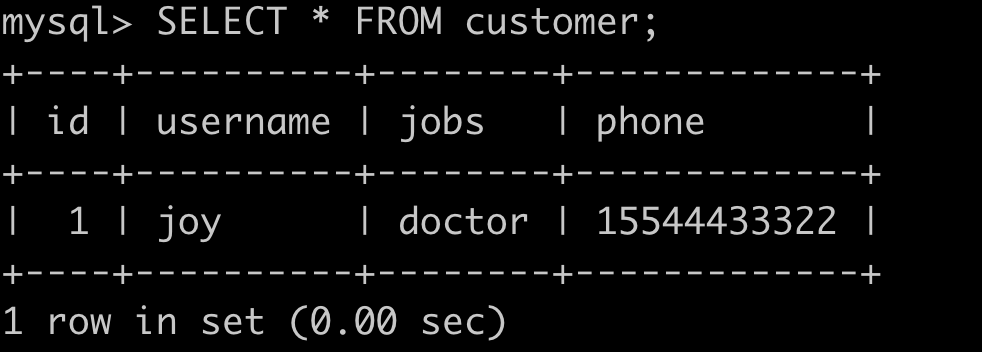
创建项目
我们创建一个Maven项目,不会的请回Spring初步部分看看。
项目名称为top.cairbin.test4,然后修改pom.xml添加依赖项
<project xmlns="http://maven.apache.org/POM/4.0.0" xmlns:xsi="http://www.w3.org/2001/XMLSchema-instance"
xsi:schemaLocation="http://maven.apache.org/POM/4.0.0 http://maven.apache.org/xsd/maven-4.0.0.xsd">
<modelVersion>4.0.0</modelVersion>
<groupId>top.cairbin</groupId>
<artifactId>test4</artifactId>
<version>0.0.1-SNAPSHOT</version>
<packaging>jar</packaging>
<name>test4</name>
<url>http://maven.apache.org</url>
<properties>
<project.build.sourceEncoding>UTF-8</project.build.sourceEncoding>
</properties>
<dependencies>
<dependency>
<groupId>junit</groupId>
<artifactId>junit</artifactId>
<version>4.12</version>
<scope>test</scope>
</dependency>
<dependency>
<groupId>org.mybatis</groupId>
<artifactId>mybatis</artifactId>
<version>3.5.5</version>
</dependency>
<dependency>
<groupId>mysql</groupId>
<artifactId>mysql-connector-java</artifactId>
<version>8.0.33</version>
</dependency>
<dependency>
<groupId>org.mybatis.generator</groupId>
<artifactId>mybatis-generator-core</artifactId>
<version>1.4.0</version>
</dependency>
</dependencies>
</project>我们创建一个resources文件夹,并use as source folder
在里面创建一个log4j.properties,可以让我们在控制台看到SQL语句
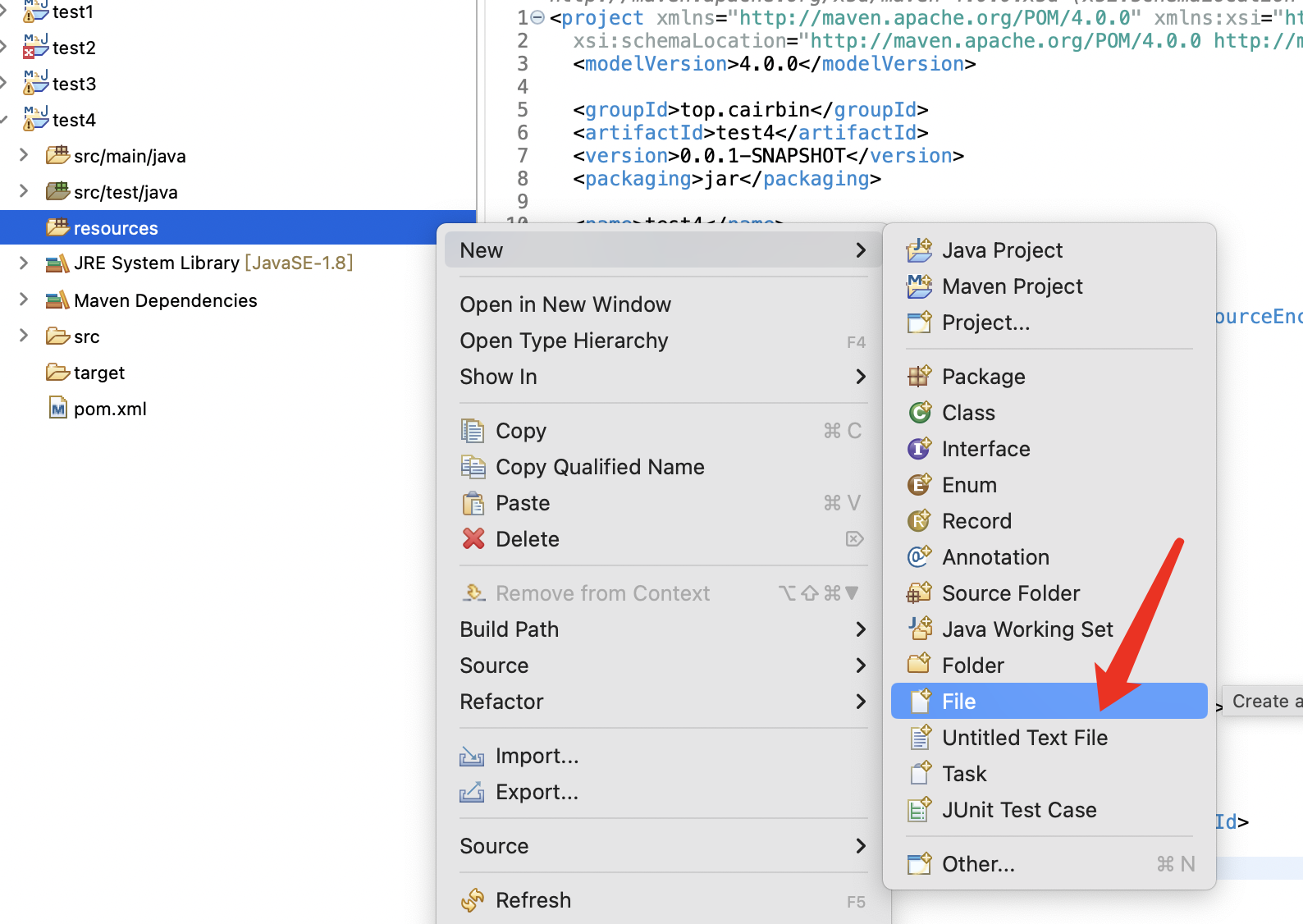
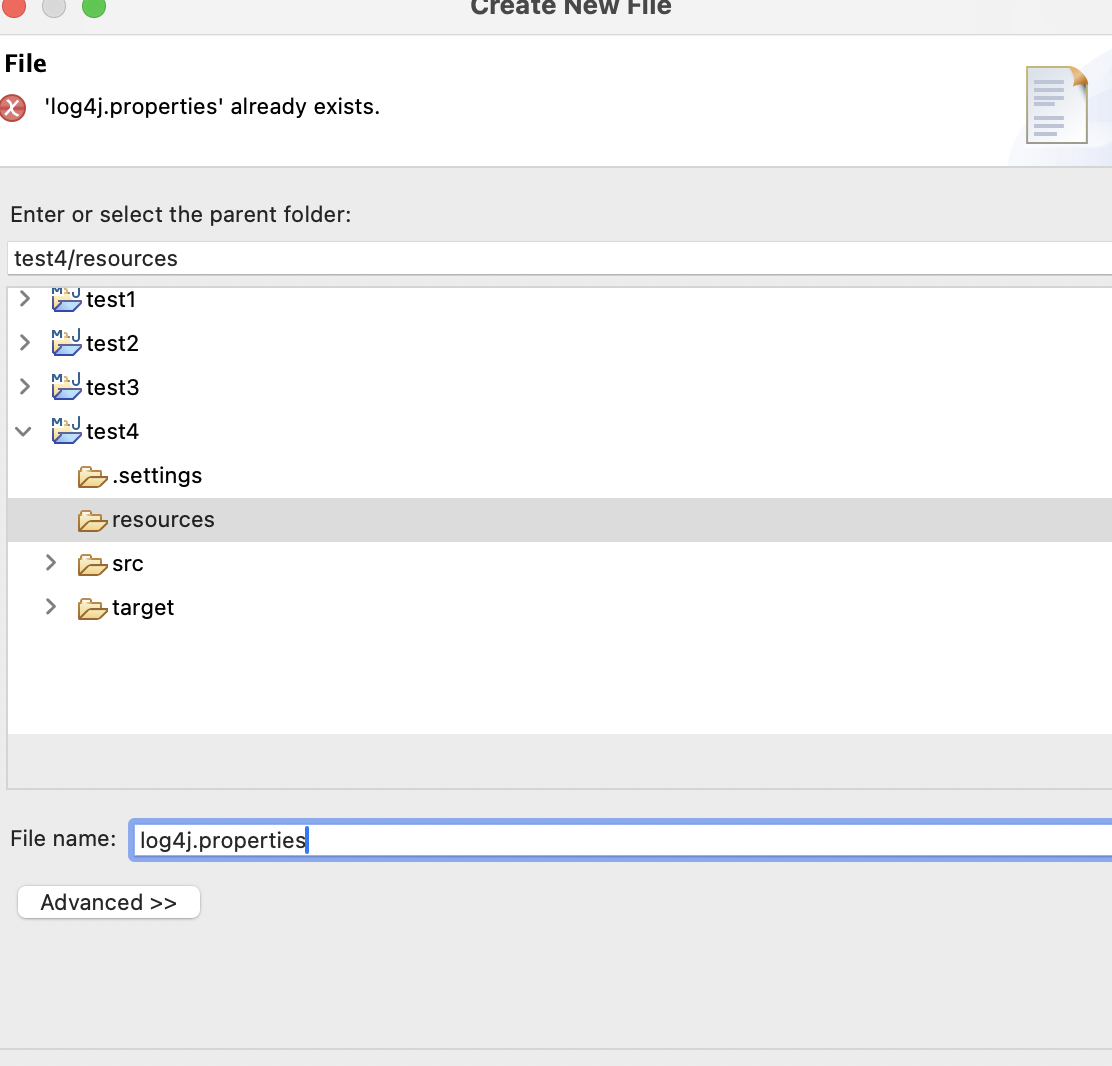
# Global logging configuration
log4j.rootLogger=ERROR, stdout
# MyBatis logging configuration...
log4j.logger.top.cairbin.test4=DEBUG
# Console output...
log4j.appender.stdout=org.apache.log4j.ConsoleAppender
log4j.appender.stdout.layout=org.apache.log4j.PatternLayout
log4j.appender.stdout.layout.ConversionPattern=%5p [%t] - %m%n在src/main/java下的top.cairbin.test4包下创建一个持久化类Customer
package top.cairbin.test4;
public class Customer {
private Integer id; // 主键id
private String username; // 客户名称
private String jobs; // 职业
private String phone; // 电话
public void setId(Integer id) {
this.id = id;
}
public Integer getId() {
return this.id;
}
public void setUsername(String username) {
this.username = username;
}
public String getUsername() {
return username;
}
public void setJobs(String jobs) {
this.jobs = jobs;
}
public String getJobs() {
return this.jobs;
}
public void setPhone(String phone) {
this.phone = phone;
}
public String getPhone() {
return this.phone;
}
//为了方便测试时输出结果,建议生成toString()方法。
@Override
public String toString() {
return "Customer [id=" + id + ", username=" + username +
", jobs=" + jobs + ", phone=" + phone + "]";
}
}在top.cairbin.test4下创建一个映射文件CustomerMapper.xml,注意<mapper>标签的namespace属性。
<?xml version="1.0" encoding="UTF-8"?>
<!DOCTYPE mapper PUBLIC "-//mybatis.org//DTD Mapper 3.0//EN"
"http://mybatis.org/dtd/mybatis-3-mapper.dtd">
<!-- namespace表示命名空间 -->
<mapper namespace="top.cairbin.test4.CustomerMapper">
<!--根据客户编号获取客户信息 -->
<select id="findCustomerById" parameterType="Integer"
resultType="top.cairbin.test4.Customer">
select * from customer where id = #{id}
</select>
</mapper>在resources文件夹里新建一个mybatis核心配置文件mybatis-config.xml
<?xml version="1.0" encoding="UTF-8" ?>
<!DOCTYPE configuration PUBLIC "-//mybatis.org//DTD Config 3.0//EN"
"http://mybatis.org/dtd/mybatis-3-config.dtd">
<configuration>
<settings>
<setting name="mapUnderscoreToCamelCase" value="true" />
<setting name="logImpl" value="STDOUT_LOGGING" />
</settings>
<!--1.配置环境 ,默认的环境id为mysql -->
<environments default="mysql">
<!--1.2.配置id为mysql的数据库环境 -->
<environment id="mysql">
<!-- 使用JDBC的事务管理 -->
<transactionManager type="JDBC" />
<!--数据库连接池 -->
<dataSource type="POOLED">
<property name="driver" value="com.mysql.jdbc.Driver" />
<property name="url"
value="jdbc:mysql://localhost:3306/db_mybatis" />
<property name="username" value="db_mybatis" />
<property name="password" value="db_mybatis" />
</dataSource>
</environment>
</environments>
<!--2.配置Mapper的位置 -->
<mappers>
<mapper resource="top/cairbin/test4/CustomerMapper.xml" />
</mappers>
</configuration>注意这里的位置
<mappers>
<mapper resource="top/cairbin/test4/CustomerMapper.xml" />
</mappers>我们在src/test/java目录下创建测试类MyBatisTest
package top.cairbin.test4;
import java.io.InputStream;
import java.util.List;
import org.apache.ibatis.io.Resources;
import org.apache.ibatis.session.SqlSession;
import org.apache.ibatis.session.SqlSessionFactory;
import org.apache.ibatis.session.SqlSessionFactoryBuilder;
import org.junit.Test;
import top.cairbin.test4.*;
public class MyBatisTest {
/**
* 根据客户编号查询客户信息
*/
@Test
public void findCustomerByIdTest() throws Exception {
// 1、读取配置文件
String resource = "mybatis-config.xml";
InputStream inputStream =
Resources.getResourceAsStream(resource);
// 2、根据配置文件构建SqlSessionFactory
SqlSessionFactory sqlSessionFactory =
new SqlSessionFactoryBuilder().build(inputStream);
// 3、通过SqlSessionFactory创建SqlSession
SqlSession sqlSession = sqlSessionFactory.openSession();
// 4、SqlSession执行映射文件中定义的SQL,并返回映射结果
Customer customer = sqlSession.selectOne("top.cairbin.test4" + ".CustomerMapper. findCustomerById", 1);
// 打印输出结果,Customer类中记得生成toString()方法。
System.out.println(customer.toString());
// 5、关闭SqlSession
sqlSession.close();
}
}注意这条语句
Customer customer = sqlSession.selectOne("top.cairbin.test4" + ".CustomerMapper. findCustomerById", 1);我们正是在调用刚才在CustomerMapper.xml里编写的方法,对应<select>标签的id属性。
点击运行看到输出结果

在CustomerMapper.xml映射文件中添加模糊查询,添加,更新和删除的配置,在测试类中添加对应的测试方法,然后进行测试。
注意每一个方法的parameterType和resultType属性对应的包。
<?xml version="1.0" encoding="UTF-8"?>
<!DOCTYPE mapper PUBLIC "-//mybatis.org//DTD Mapper 3.0//EN"
"http://mybatis.org/dtd/mybatis-3-mapper.dtd">
<!-- namespace表示命名空间 -->
<mapper namespace="top.cairbin.test4.CustomerMapper">
<!--根据客户编号获取客户信息(如果使用的生成类MBGTest.java生成的映射文件,可以不用添加如下内容,直接使用里面的selectByPrimaryKey方法。) -->
<select id=" findCustomerById" parameterType="Integer"
resultType="top.cairbin.test4.Customer">
select * from customer where id = #{id}
</select>
<!--根据客户名模糊查询客户信息列表-->
<select id="findCustomerByName" parameterType="String"
resultType="top.cairbin.test4.Customer">
<!-- select * from customer where username like '%${value}%' -->
select * from customer where username like concat('%',#{value},'%')
</select>
<insert id="addCustomer" parameterType="top.cairbin.test4.Customer">
insert into customer(username,jobs,phone)
values(#{username},#{jobs},#{phone})
</insert>
<update id="updateCustomer" parameterType="top.cairbin.test4.Customer">
update customer set
username=#{username},jobs=#{jobs},phone=#{phone}
where id=#{id}
</update>
<delete id="deleteCustomer" parameterType="Integer">
delete from customer where id=#{id}
</delete>
</mapper>同样的测试类修改为(请注意代码中的包名)
package top.cairbin.test4;
import java.io.InputStream;
import java.util.List;
import org.apache.ibatis.io.Resources;
import org.apache.ibatis.session.SqlSession;
import org.apache.ibatis.session.SqlSessionFactory;
import org.apache.ibatis.session.SqlSessionFactoryBuilder;
import org.junit.Test;
import top.cairbin.test4.*;
public class MyBatisTest {
/**
* 根据客户编号查询客户信息
*/
@Test
public void findCustomerByIdTest() throws Exception {
// 1、读取配置文件
String resource = "mybatis-config.xml";
InputStream inputStream =
Resources.getResourceAsStream(resource);
// 2、根据配置文件构建SqlSessionFactory
SqlSessionFactory sqlSessionFactory =
new SqlSessionFactoryBuilder().build(inputStream);
// 3、通过SqlSessionFactory创建SqlSession
SqlSession sqlSession = sqlSessionFactory.openSession();
// 4、SqlSession执行映射文件中定义的SQL,并返回映射结果
Customer customer = sqlSession.selectOne("top.cairbin.test4" + ".CustomerMapper. findCustomerById", 1);
// 打印输出结果,Customer类中记得生成toString()方法。
System.out.println(customer.toString());
// 5、关闭SqlSession
sqlSession.close();
}
/**
* 根据用户名称来模糊查询用户信息列表
*/
@Test
public void findCustomerByNameTest() throws Exception{
// 1、读取配置文件
String resource = "mybatis-config.xml";
InputStream inputStream = Resources.getResourceAsStream(resource);
// 2、根据配置文件构建SqlSessionFactory
SqlSessionFactory sqlSessionFactory =
new SqlSessionFactoryBuilder().build(inputStream);
// 3、通过SqlSessionFactory创建SqlSession
SqlSession sqlSession = sqlSessionFactory.openSession();
// 4、SqlSession执行映射文件中定义的SQL,并返回映射结果
List<Customer> customers = sqlSession.selectList("top.cairbin.test4"
+ ".CustomerMapper.findCustomerByName", "j");
for (Customer customer : customers) {
//打印输出结果集
System.out.println(customer);
}
// 5、关闭SqlSession
sqlSession.close();
}
/**
* 添加客户
*/
@Test
public void addCustomerTest() throws Exception{
// 1、读取配置文件
String resource = "mybatis-config.xml";
InputStream inputStream = Resources.getResourceAsStream(resource);
// 2、根据配置文件构建SqlSessionFactory
SqlSessionFactory sqlSessionFactory =
new SqlSessionFactoryBuilder().build(inputStream);
// 3、通过SqlSessionFactory创建SqlSession
SqlSession sqlSession = sqlSessionFactory.openSession();
// 4、SqlSession执行添加操作
// 4.1创建Customer对象,并向对象中添加数据
Customer customer = new Customer();
customer.setUsername("rose");
customer.setJobs("student");
customer.setPhone("13333533092");
// 4.2执行SqlSession的插入方法,返回的是SQL语句影响的行数
int rows = sqlSession.insert("top.cairbin.test4"
+ ".CustomerMapper.addCustomer", customer);
// 4.3通过返回结果判断插入操作是否执行成功
if(rows > 0){
System.out.println("您成功插入了"+rows+"条数据!");
}else{
System.out.println("执行插入操作失败!!!");
}
// 4.4提交事务
sqlSession.commit();
// 5、关闭SqlSession
sqlSession.close();
}
/**
* 更新客户
*/
@Test
public void updateCustomerTest() throws Exception{
// 1、读取配置文件
String resource = "mybatis-config.xml";
InputStream inputStream = Resources.getResourceAsStream(resource);
// 2、根据配置文件构建SqlSessionFactory
SqlSessionFactory sqlSessionFactory =
new SqlSessionFactoryBuilder().build(inputStream);
// 3、通过SqlSessionFactory创建SqlSession
SqlSession sqlSession = sqlSessionFactory.openSession();
// 4、SqlSession执行更新操作
// 4.1创建Customer对象,对对象中的数据进行模拟更新
Customer customer = new Customer();
customer.setId(2); //注意该id必须是你数据库中已有的id.
customer.setUsername("rose");
customer.setJobs("programmer");
customer.setPhone("13311111111");
// 4.2执行SqlSession的更新方法,返回的是SQL语句影响的行数
int rows = sqlSession.update("top.cairbin.test4"
+ ".CustomerMapper.updateCustomer", customer);
// 4.3通过返回结果判断更新操作是否执行成功
if(rows > 0){
System.out.println("您成功修改了"+rows+"条数据!");
}else{
System.out.println("执行修改操作失败!!!");
}
// 4.4提交事务
sqlSession.commit();
// 5、关闭SqlSession
sqlSession.close();
}
/**
* 删除客户
*/
@Test
public void deleteCustomerTest() throws Exception{
// 1、读取配置文件
String resource = "mybatis-config.xml";
InputStream inputStream = Resources.getResourceAsStream(resource);
// 2、根据配置文件构建SqlSessionFactory
SqlSessionFactory sqlSessionFactory =
new SqlSessionFactoryBuilder().build(inputStream);
// 3、通过SqlSessionFactory创建SqlSession
SqlSession sqlSession = sqlSessionFactory.openSession();
// 4、SqlSession执行删除操作
// 4.1执行SqlSession的删除方法,返回的是SQL语句影响的行数
int rows = sqlSession.delete("top.cairbin.test4"
+ ".CustomerMapper.deleteCustomer", 2); //注意该id必须是你数据库中已有的id.
// 4.2通过返回结果判断删除操作是否执行成功
if(rows > 0){
System.out.println("您成功删除了"+rows+"条数据!");
}else{
System.out.println("执行删除操作失败!!!");
}
// 4.3提交事务
sqlSession.commit();
// 5、关闭SqlSession
sqlSession.close();
}
}运行,然后测试即可。
